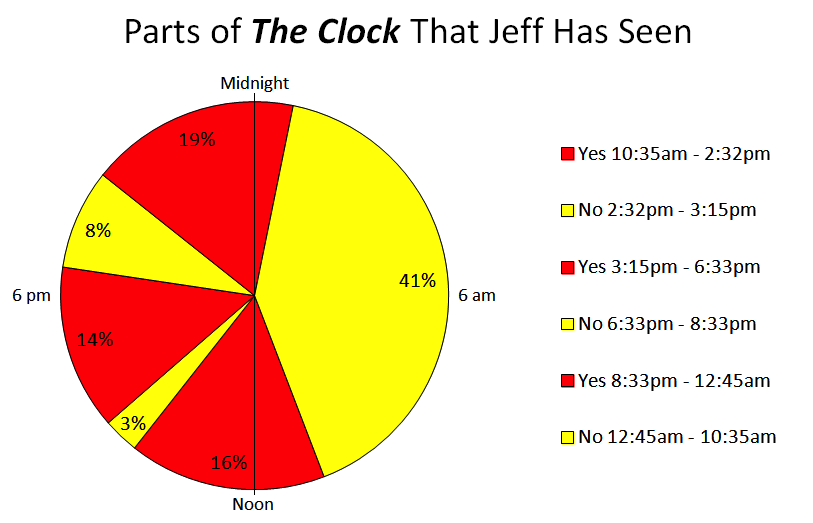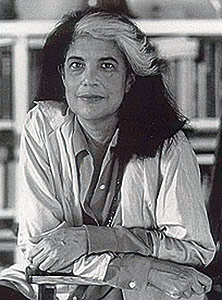This afternoon I spent 3 hours and 18 minutes watching The Clock, by Christian Marclay, at Lincoln Center. It was fascinating and profound.
It’s easy to describe The Clock, but it’s not easy to describe the experience of watching it.
The Clock is a 24-hour montage of movie clips that feature clocks or mentions of the current time, shown in real time. For example, if it’s 6:05 p.m. when you’re watching, it’s 6:05 p.m. on screen. Sometimes the clips are edited together to show similarities, other times to show odd juxtapositions. The sound from one clip sometimes bleeds into another. The clips come from all decades and genres and countries (though mostly American and British), in black and white and in color, in various moods. It’s like a Chuck Workman montage on steroids. The experience is addictive and hypnotic.
Lincoln Center is showing it through August 1. Admission is free, and you can stay as long as you like, but there can be a wait, because there are only about 100 seats. When I arrived this afternoon, I was told the wait was about 90 minutes, but I wasn’t doing anything else, so I decided to go for it.
Once I got in, I intended to stay for at least an hour, maybe two hours tops. But I wound up watching for more than three hours — from 3:14 pm to 6:32 pm.
The thing is, it’s easy to stay longer than you intend. You constantly know what time it is, and yet you also lose track of time. Even though the film is essentially a few thousand movie clips chopped up in a blender, a sort of narrative tension emerges. You keep wanting to wait and see what the next clip will bring… and the next… and the next…
There is also some built-in narrative structure. Starting at 15 minutes before the top of the hour, you see a lot more clips of people anticipating things that are about to happen. In movies, important things happen at the top of the hour: the bomb explodes, the train leaves, the store closes, the alarm goes off. As I neared the top of an hour, I had to wait and see what would happen. I watched what happened at 4:00 pm, then stuck around for 5:00 pm, and then before I knew it, it was nearly 6:00 pm, so I had to stay for that, too.
As the clock ticked down from 4:59 to 5:00 pm, Jack Nicholson in About Schmidt sat in his office, staring at the clock on the wall, waiting for his last day of work to end and his retirement to begin.
Just after 6:00 pm, Mr. Banks of Mary Poppins walked through the door of his house singing “The Life I Lead”:
I run my home precisely on schedule
At 6:01, I march through my door
My slippers, sherry, and pipe are due at 6:02…
The Clocks also shows you how movies condense the passage of time. For example, at about 4:50 pm, there was a clip of Steve Martin in Planes, Trains & Automobiles impatiently waiting for a meeting to end so he could catch a 6:00 pm flight. (We see 6:00 on his plane ticket.) Over an hour later, we see another clip from the same movie as he rushes through the airport to catch his plane, only to find it’s been delayed.
Similarly, four or five clips from The Time Machine appeared over the course of an hour. (And I saw three clips from One Hour Photo; that was kind of odd.)
At one point, something freaky happened. I suddenly wondered if there would be a clip from Clue — and less than five minutes later, there was. It was uncanny. I don’t remember what time anything happens in Clue, but something about the time of day — early evening — must have made me think about it.
Because that’s another thing: you can feel the mood of different times of day while watching The Clock. The late afternoon feels like a long stretch of indefinable time: people have trysts, children stare at the clock waiting to get out of school. At 5:00, work ends. In the 5:00 hour there are a couple of clips of children eating dinner, then as it gets later, people start making dinner, and other people start looking forward to their evening plans.
Watching The Clock, you really come to feel like “The Movies” exists as a separate, palpable, ongoing world where every year, every event, every reality is happening simultaneously. The feeling is heightened by knowing that The Clock is still going on right now even though I’m not there. It’s like there’s this alternate universe where things are happening right now — an alternate universality.
It was such an amazing experience. I wish I could see the whole thing. And I regret that I won’t be watching at 10:04 pm, when lightning strikes the clock tower in Back to the Future.
MOMA has apparently bought a copy of The Clock, so if you live in New York and won’t get a chance to see it this time around, you’ll get another opportunity.
It really should be available to stream online, so more people could see it.



